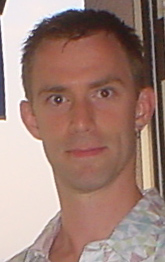Our Science – Shaffer Website
Arthur L. Shaffer III, Ph.D.
 |
|
|||||||||||||||||||||
Biography
Born 9-21-1967, New Cumberland, PA
EDUCATION
Ph.D. Molecular Biology and Genetics/Immunology 1991- 1996
Graduate Program in Immunology
Johns Hopkins University School of Medicine
Baltimore, MD
B.A. Biology 1985-1989
Department of Biology/University Honors Program
University of Delaware
Newark, DE
PROFESSIONAL/RESEARCH EXPERIENCE
Staff Scientist
2001-present
National Cancer Institute, National Institutes of Health
Bethesda, MD
Research Focus: Gene expression analysis of normal
immune system development and lymphomagenesis.
Principal Investigator: Louis M. Staudt, M.D., Ph.D.
Post-Doctoral Fellow 1996-2001
National Cancer Institute, National Institutes of Health
Bethesda, MD
Research Focus: Molecular analysis of the regulation
and targets of BCL-6, a transcriptional repressor that
causes human lymphoma.
Principal Investigator: Louis M. Staudt, M.D., Ph.D.
Candidate, Doctor of Philosophy 1991-1996
Graduate Program in Immunology
Johns Hopkins University School of Medicine
Baltimore, MD.
Thesis: The Role of the pre-B Cell Receptor in B
Cell Development.
Advisor: Mark Schlissel, M.D., Ph.D.
ACTIVITIES
Co-editor Immunological Reviews: Genomics and
Proteomics Issue
with Dr. Louis M. Staudt
Publication scheduled for 1/2006
Co-organizer B Cell Workshop
2000-present
National Cancer Institute, National Institutes of Health
Bethesda, MD
Recruit speakers and organize a weekly meeting of intra-
and extra-mural scientists interested in B cell biology
NIH Immunology Interest Group (IIG) Steering Committee: Staff Scientist Representative 2004-present
National Institutes of Health, Immunology Interest Group
(IIG), Steering Committee,
Bethesda, MD
Participate in the organization of a weekly NIH-wide
Immunology seminar series as well as the annual NIH
Immunolgy retreat, serving the 1500 members of the IIG.
Instructor, FAES Immunology Course (IMMU504) 2003 and 2005
NIH, Bethesda MD
Taught the B cell Development Lecture,
developed handouts and test questions
RECENT PUBLICATIONS
Seong-Su Han, Arthur L Shaffer, Liangping Peng, Seung-Tae Chung,
Jae-Hwan Lim, Sungho Maeng, Joong Su Kim, Nicole McNeil, Thomas Ried, Louis M Staudt and Siegfried Janz (2005) Molecular and cytological features of the mouse B-cell lymphoma line iMycEm-1. Molecular Cancer, in press.
Arthur L. Shaffer*, Sung Sup Park*, Joong Su Kim* , Wendy duBois , Michael Potter, Louis M. Staudt and Siegfried Janz. (2005) Insertion of Myc into Igh accelerates peritoneal plasmacytomas in mice. Cancer Res 65 (17), p7644-7652. *equal coauthors
Shaffer, A.L., Miriam Shapiro-Shelef, Neal N. Iwakoshi, Ann-Hwee Lee, Shu-Bing Qian , Hong Zhao, Xin Yu, Liming Yang, Bruce K. Tan, Andreas Rosenwald,Elaine M. Hurt, Emmanuel Petroulakis, Nahum Sonenberg, Jonathan W. Yewdell , Kathryn Calame, Laurie H. Glimcher, and Louis M. Staudt (2004) XBP1, downstream of Blimp-1, expands the secretory apparatus and other organelles, and increase protein synthesis in plasma cell differentiation. Immunity 21, 81-93.
Chainarong Tunyaplin, A. L. Shaffer, Cristina D. Angelin-Duclos, Xin Yu,
Louis M. Staudt, and Kathryn L. Calame (2004) Direct Repression of prdm1 by Bcl-6 Inhibits Plasmacytic Differentiation. J. Immunol 173 (2), 1158-65.
Hurt, E.M., Adrian Wiestner, Andreas Rosenwald, A.L. Shaffer, Elias
Campo, Tom Grogan, P. Leif Bergsagel, W. Michael Kuehl, and Louis M.
Staudt. (2004) Overexpression of c-maf is a frequent oncogenic event in
multiple myeloma that promotes proliferation and pathological interactions
with bone marrow. Cancer Cell 5, 191-199.
Shaffer, A.L., Rosenwald, A., and Staudt, L.M. (2002) Lymphoid Malignancies: the dark side of B cell differentiation. Nature Reviews in Immunology 2, 920-932.
Shaffer,A.L., Kuo–I Lin, Tracy C. Kuo, Xin Yu, Elaine M. Hurt, Andreas Rosenwald, Jena M. Giltnane, Liming Yang, Hong Zhao, Kathryn Calame, Louis M. Staudt (2002) Blimp-1 orchestrates plasma cell differentiation by extinguishing the mature B cell gene expression program. Immunity 17, 51-62.
Shaffer, A.L., Rosenwald, A., Hurt, E.M., Giltnane, J.M., Lam L.T., Pickeral, O.K. and Staudt, L.M. (2001) Signatures of the Immune Response. Immunity 15, 375-385.
ONGOING COLLABORATIONS
1. Dr. Mike Potter and Dr. Sigfried Janz,
NCI NIH
Analysis of mouse tumor models and plasmacytomas using Mouse Lymphochips
2. Dr. Harinder Singh and Dr. Roger Sciammas,
University of Chicago
The role of IRF4 in normal and malignant B cell devlopement
3. Dr. Kathryn Calame,
Columbia University
The role of Blimp-1 in cellular differentiation
4. Dr. Phil Tucker,
University of Texas at Austin
The BCL11 oncogene, a key developmental gene for B cells
Research
Use gene expression profiling to understand normal and malignant B cell differentiation.
Develop novel assays for the diagnosis and treatment of B cell lymphoma.
Develop tools for the analysis of gene expression data.
This page was last updated on 7/15/2008.

